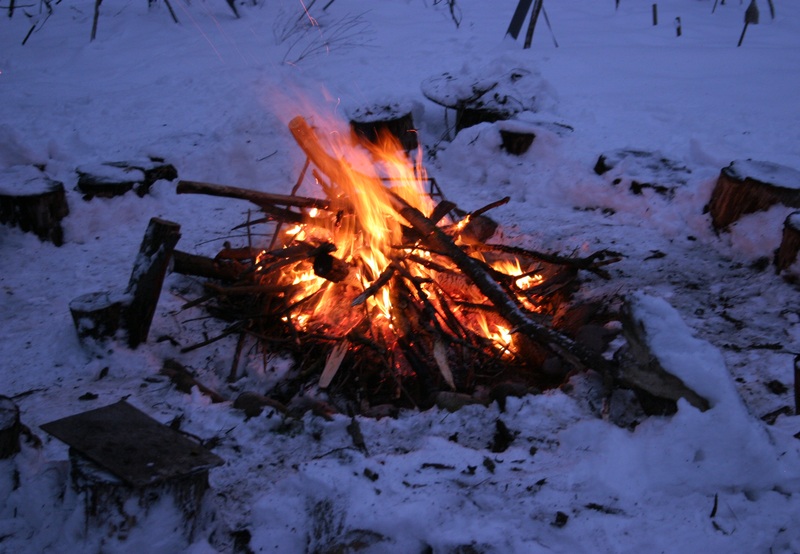Winter survival is an animal unto its own; while there is overlap for venturing into the wild in other seasons, Winter requires a completely different tool, supply and skill set.
The following are the basics.
Winter Bug Out Bag List
Since your survival needs will change depending on the season, it’s a good idea to pack a separate bug out bag for winter, filled with basic bug out bag essentials as well as items that are necessary to survive in the cold. Here are a few items that should be included in your winter bug out bag:
• Modern fire starters
• Folding saw
• Reflector blankets
• Hand and body warmers
• Metal cups
• Ice fishing supplies
• Wool socks
• Long underwear
• Ski mask and goggles
• Insulated water bottle
• Shovel
• Cold weather sleeping bagPriorities for Winter Survival
Warmth
Despite popular belief, your first priority in a survival situation shouldn’t be food or even water, but shelter. This is especially true in the winter months, when exposure to the elements even for a few minutes can be dangerous. Before you do anything else, make sure you have adequate shelter and fire to maintain your body’s much-needed warmth. Only after you’ve done this should you concern yourself with finding food, water and other survival essentials.
Water
After shelter, water is the most pressing need in a survival situation. While a person can survive a month or more without food, you can only go three days without water (remember the Survival Rule of Threes.) You should also keep in mind that drinking cold water or eating snow in winter will cause your body to burn excessive calories which your body desperately needs to stay alive. In a winter survival situation, you should always heat up water before drinking it.
Finding Shelter
The type of shelter you need will largely depend on your unique situation. If you get stranded in a vehicle in winter, it is almost always preferable to stay put in your vehicle until help arrives. If you’re not in a vehicle, use whatever materials you can find to construct a shelter to protect yourself from the elements. Keep an eye out for caves or rock overhangs, as these can make for great survival shelters. Alternately, you can dig into a snow drift to create a makeshift “snow cave.” These are just a few ways to find or create shelter in the winter.
Staying Hydrated
Aside from shelter, water is the most crucial thing to focus on in a survival situation. Fortunately, winter often means there is water readily available in the form of snow and ice. After melting the snow or ice down into water, you still need to heat it up before you drink it, since drinking cold water in the winter will make you colder and cause your body to expend more calories. This is where a metal pot or cup comes in handy, as it can be safely and easily heated over an open flame.
Signaling for Help
The difficulty of finding a lost or stranded hiker can become even greater in the winter, when the glare off the snow can cause decreased visibility, and the elements make it difficult for others to get to you. If you plan on venturing out in the winter, always leave a detailed itinerary behind so that rescuers will know where to look for you. It’s also important that you stay put. Use fire, smoke, reflective blankets, signal flares and other methods to try and call attention to yourself so that rescuers will have an easier time finding you.
Safety Reminders
• Cotton kills. Once cotton is wet, it’s no longer able to keep you warm. Opt for a warmer fabric such as wool.
• Prevent hypothermia. Wear proper clothing, stay dry, and wear a hat. Also stay out of the wind, build a fire, stay active, and eat energy-rich food.
• Identify and treat frostbite. Frostbite symptoms include cold and “tingly” ears, nose, fingers and toes; numbness in the extremities; and waxy, stiff skin that limits joint movement. For mild frostbite, warm the area with skin-to-skin contact for 15 minutes; for superficial frostbite, splint and cover the affected area, loosen clothing, and seek medical attention; for deep frostbite, rescue and evacuation is the only cure.
The key to winter survival is to remember that unless it is asleep, virtually everything that can hurt, maim and kill you in July or August still exists, except you now have to contend with cold, little vegetation, sparse game and everything is covered in frozen white stuff.
Other than that, it is easy.
That is why you must enter winter excursions with a different mentality and be fully prepared for different challenges should a survival crisis rear its ugly head.
To learn more about surviving in the wild in winter, check out Survival Life.
